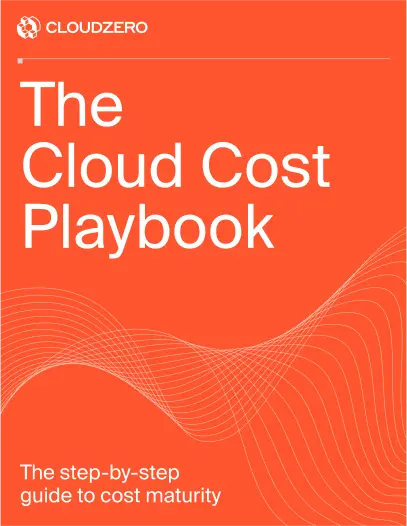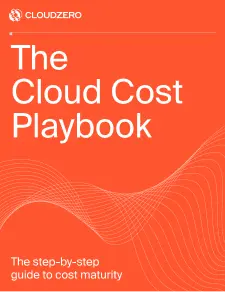Cloud migration is the new gold rush, judging from the results of a survey involving 1,283 IT professionals.
The survey shows that 88% of companies already use the cloud for some applications and data. Another 80% said they will have moved to cloud and co-location services by 2025.
While 87% of respondents said the pandemic accelerated their cloud migration strategy, many companies’ transition plans had been in the works for years.
Moving to the cloud can offer numerous benefits, as many companies have realized. In addition, it can also present several challenges that make migration challenging.
What are the benefits, the challenges, and how do you complete a successful migration for your organization?
We’ll cover all of these questions in detail, including how cloud migration works, its advantages and disadvantages, migration strategies, steps, and tools you can use to succeed.
What Is Cloud Migration?
Cloud migration is the process of moving all or part of an on-premise IT infrastructure to the cloud. This might include company applications, data, processes, and more — with the goal of migration often being to reduce costs and to be able to scale quicker.
On-premises components include any hardware or software you run in a physical building, primarily where your employees work. By moving to the cloud, you switch from an on-premises platform to a cloud-based one.
What are the three types of cloud migrations?
Cloud migration often involves transferring data from on-site infrastructure to cloud infrastructure. A typical scenario involves moving data from a legacy system to the cloud.
Legacy systems include outdated or suboptimal components for the job they are intended to do. They include slow servers, outdated networking equipment, obsolete databases, and applications that no longer receive security patches from their vendors.
Furthermore, you can complete a cloud migration by switching from one cloud computing provider to another. This migration approach is called a cloud-to-cloud migration. For example, you can switch from Google Cloud Platform (GCP) to either Microsoft Azure Cloud Services or Amazon Web Services (AWS), and vice versa.
The third type of transition is reverse cloud migration, which involves transferring applications and data from the cloud to an on-site environment. Declouding, unclouding, or cloud repatriation are other names for it.
What Are The Benefits Of Migrating To The Cloud?
According to Gartner, the global public cloud services market will grow by 88.2 billion dollars between 2020 and 2022.
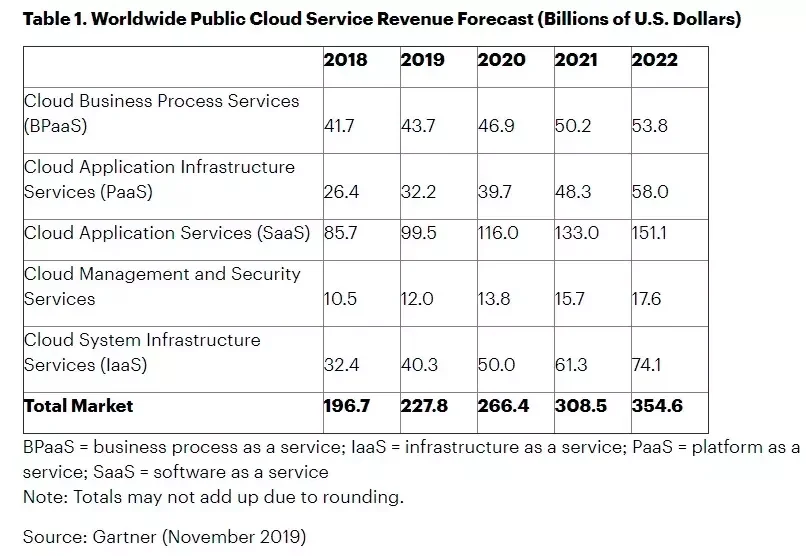
Public cloud adoption dominated IT spending during the pandemic, according to Deloitte. Why are organizations migrating to the cloud so rapidly?
There are several powerful reasons to migrate to the cloud. Below are a few you’ll want to consider.
1. Application modernization
Providing services in the cloud requires you to make infrastructure components cloud-compatible. There are several cloud computing best practices that your company needs to meet to achieve seamless operations in the cloud. It can help make your digital transformation seamless.
Using modern data systems almost always boosts the performance of cloud-based applications, for example — which can improve your customers’ experiences.
2. Cost benefits
Buying, running, and maintaining on-premises hardware and software can be a costly affair.
The cloud provider handles most of the maintenance work on the cloud, including server performance, platform updates, and other host management tasks.
There is minimal equipment to buy, run, or maintain on a cloud platform. Cloud computing services also come at competitive prices, which translates to more IT cost savings for you.
3. Moving to the cloud sets your team free to complete critical tasks
An on-premises system requires constant care, which takes a lot of time and effort. This leads to significant productivity loss.
Migration to the cloud takes the burden off of your team and puts it in the hands of cloud providers who are equally or more capable.
4. Meet customer expectations
Modern customers expect to access services at any time, from anywhere.
But the farther they are from your on-premises databases and servers, the greater the chance of experiencing latency.
Cloud computing helps customers in multiple locations access seamless services using the nearest data centers, reducing lag issues. This can help you enhance customer experiences and open up international markets.
5. Enhance scalability
Today, viral campaigns can drastically change the course of your business. Cloud computing enables your IT infrastructure to adapt to spikes in online traffic, such as increased server requests from a viral campaign — without slowing down your system. The cloud makes it easier to scale up and down resources as your needs fluctuate.
6. Improve flexibility
When your core business must pivot to survive, the cloud can offer a quick and relatively inexpensive solution. You don’t have to worry about spending more money on new equipment or what to do with no-longer-needed infrastructure components.
7. Support remote teams
With cloud migration, organizations can shift to a hybrid workspace that empowers distributed teams to collaborate in real-time. So, you can hire talent from around the world or coordinate team members working remotely.
8. Take advantage of continuous deployment strategies
Cloud computing is an excellent system for startups looking to launch bare-bones products. They can use continuous integration (CI) to release additional features as they go while patching security concerns as they occur.
For larger SMBs and enterprises, migration to the cloud means system updates take minimal time to avoid significant disruptions — and that is just one example.
9. Lead your competitors
Combining these benefits gives you a competitive edge in cost savings, better system performance, team productivity, and customer satisfaction. This can translate to new and long-term business for you.
What can you do to take advantage of those benefits in the cloud?
It’s likely that you already benefit from some of the benefits of cloud computing. But what if you want to go all-in, as we see many companies do, in the wake of the new normal?
You’ll want to start by preparing a cloud migration strategy. You can do it easily when you know what to do. Here’s what to know.
What Is A Cloud Migration Strategy?
A cloud migration strategy is a unique plan that an organization creates to help transition its on-prem data and applications to the cloud.
Cloud migration requires significant preparation.
For example, a good cloud migration strategy will always consider the most efficient way to move to the cloud. Cloud migration success requires balancing the benefits, challenges, and suitability of specific aspects.
Here is a breakdown of the two aspects crucial for implementing a cloud migration strategy.
What Cloud Migration Strategies Exist?
The first step is to choose a cloud deployment model and platform that fits your business use cases.
There are four cloud computing deployment models: private cloud, public cloud, hybrid cloud, and multi-cloud.
A provider’s platform is one of three types of cloud computing services; IaaS, PaaS, and SaaS. Each cloud service model may have different advantages and disadvantages depending on your organization’s needs.
So, what is the best cloud migration strategy for your organization?
Consider the 6 Rs for migrating to the cloud:
- Rehosting
- Re-platforming
- Repurchasing
- Refactoring
- Retiring
- Retaining
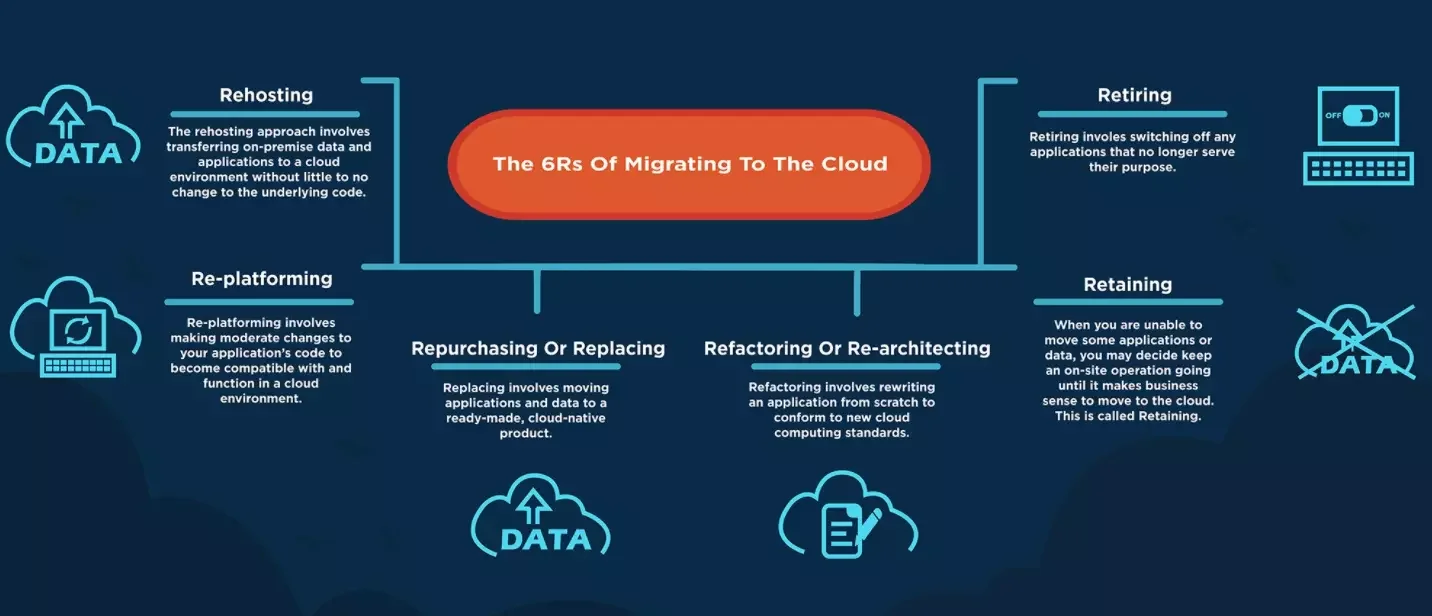
The following is a quick summary of each migration strategy.
1. Rehosting
Rehosting involves moving on-premise data and applications to the cloud without significantly changing the underlying code. This is the simplest, most cost-effective, and least time-consuming way to migrate to the cloud.
Rehosting is popular because it replicates daily activities in the cloud. That leads to a less steep learning curve and fewer disruptions.
Organizations with legacy systems can also use the “lift and shift” strategy to test the cloud’s suitability for their business processes.
For companies that want to recreate their existing framework in a cloud environment, Infrastructure-as-a-Service (IaaS) can be a good fit.
2. Replatforming
Replatforming involves modifying your applications’ code to make it compatible with and work in a cloud environment. For example, you can introduce auto-scaling, a cloud-native service.
Despite the performance improvements, the application remains mostly unchanged. This “move and improve” approach is ideal for organizations that wish to improve service delivery by modernizing legacy applications.
If you have a custom application that is less than a decade old, replatforming may be a good option.
3. Repurchasing or replacing
Replacing involves moving applications and data to a ready-made, cloud-native product. The process entails switching from an existing legacy app to a third-party Software-as-a-Software (SaaS) platform.
Getting rid of an existing system makes sense when you want to adopt new cloud computing benefits without doing all the work of building and maintaining it yourself.
It is also ideal for migrating applications and data that prove difficult to rehost or replatform.
4. Refactoring or rearchitecting
In refactoring, an application is rewritten from the ground up to conform to new cloud computing standards, features, and use cases. By redesigning your application’s components, you can transform them into cloud-native features.
Creating an application from scratch can be time-consuming and expensive. Yet, it is also the most effective and future-proof path to reap the latest cloud computing benefits, including serverless computing and native-level automation.
5. Retaining
Some things will never change.
It may not be possible to move some applications or data for various reasons, including compliance and security issues. In other cases, proceeding to the cloud may not be feasible.
In either case, you can keep an on-site operation going until it makes business sense to move to the cloud.
6. Retiring
Switching off any applications that are no longer needed makes sense as well. So, scrutinize your stack. You may discover redundancies you’ll no longer use in the new environment. You can rip out these components to free up resources for other business-critical applications.
These are some of the different cloud migration strategies you can use. Next, how do you carry out a cloud migration?
How To Migrate To The Cloud (Step-By-Step)
An effective cloud migration includes planning, selecting an appropriate cloud environment, migrating data and apps, and evaluating progress against expectations. Depending on which cloud provider you choose and your application, the exact steps will differ.
For example, GCP has its four-step migration, which differs in speed, ease, and security from migrating to AWS.
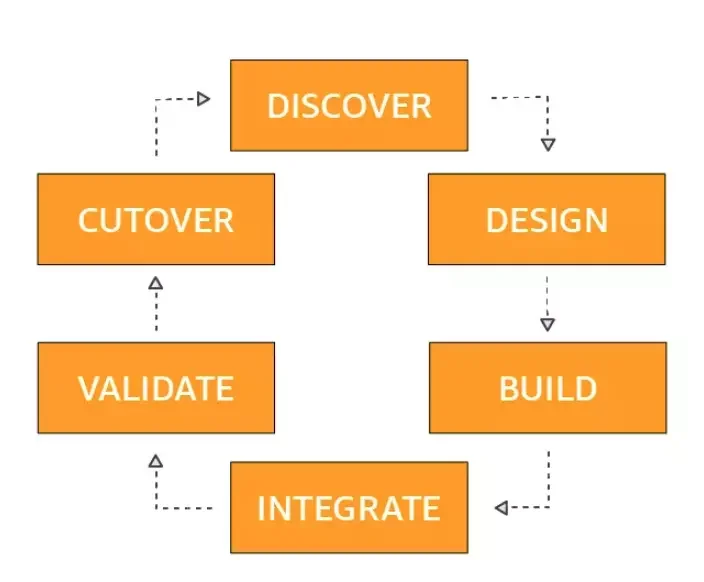
Here’s a step-by-step explanation of cloud migration.
Step 1: Plan a migration to the cloud
You first need to evaluate what business value you can derive from moving to the cloud.
- Are you losing money by retaining an on-site database?
- Do you need cloud-native features like auto-scaling and microservices to grow your business?
- Would you be willing to retrain your employees or hire new specialists to handle the latest technology?
You may wish to modernize your application to serve users worldwide or outsource server management. Maybe you want to switch to a system that allocates and charges resources based on usage instead of fixed pricing.
Cloud migrations are a significant investment, so implement them where ROI makes sense now or soon.
To create a successful migration strategy, it makes sense to consult with an experienced cloud partner. Be sure you put in place tools that will help you monitor migration costs as well.
Step 2: Choose the best cloud environment for your needs
If you want your cloud application to look, work, and feel right, you will need to communicate this to your engineering teams.
By evaluating both the benefits and drawbacks of public, private, hybrid, and multi-cloud approaches, you can pick the most suitable option for your needs.
Step 3: Migrate workloads from a local data center to the cloud
Start by installing a cloud firewall to prevent data leaks. Also, back up your data in case you need to roll back changes in case of issues such as compatibility quirks. Next, transfer your data to the cloud provider of your choice. You can upload data to the cloud over the internet.
But if you have data-heavy applications, ask your cloud provider if they do on-site data transfers. Physically shipping the data to their physical data center may also be a quicker, more secure approach.
Now is the perfect time to measure and monitor your migration costs with an automated tool — more about the tools in the next section.
Step 4: Assess your cloud migration
After your applications and data are in the new environment, you can evaluate the migration based on the KPIs you defined earlier.
- How well does the application work in the cloud?
- Would modernizing some components improve performance?
- Have you maintained data security and compliance standards throughout the process?
Something else. Comparing the new infrastructure to the old is a good idea before decommissioning on-site or legacy applications. That may mean running two environments simultaneously for some time (just in case right?)
However, it can help you evaluate whether you are achieving the cloud computing benefits you aimed for at the beginning.
You’ll only decommission legacy systems after your cloud migration specialists have given the go-ahead.
Step 5: Collect, understand, and continuously optimize your cloud costs
You’ve made it here. You are in the cloud. Now here’s the thing. We cannot stress enough how important it is for you not to skimp on collecting, analyzing, and tracking your cloud costs at this time.
Many organizations assume that the cloud will automatically reduce costs at this point. In our State of Cloud Cost Intelligence report, we found that many saw costs rise beyond what they had on-premises instead.
Here’s what we recommend (and we’ve used this method to save $1.7 million from our own infrastructure).
- Start tracking your costs as early as possible. This will help you understand your Cost of Goods Sold (COGS) as early as possible.
In turn, you will be aware when your costs are increasing, helping you to probe what’s driving the change (whether it is as a result of growth or simply overspending)
- Zoom into your costs to understand your unit economics. This means looking into your per-unit costs, such as cost per customer, per team, per feature, per environment, per service, etc. This is so you can clearly understand who, what, and why your cloud costs are the way they are. While most cost tools do not offer this level of insight, CloudZero does.
- Next, make use of the cloud cost intel. How? One example is to use your Cost per Customer data to set optimal pricing. This is the price at which you can protect your margins while giving your customers a good deal based on their usage. Win-win.
Additionally, a metric like Cost per Feature can provide you with a sense of whether a particular feature is worth keeping, repurposing, or decommissioning.
For example, you may decide to move a popular, free feature to a paid tier so it can pay for itself (not eat up your margins).
This is the essence of cloud cost optimization. It is not just about cutting costs. It is more about surfacing opportunities to move things around and see what tradeoffs to make to grow your business.
Heck, this can even lead to new revenue streams and customer segments. For example, you can use CloudZero to discover your most expensive customers (cost per customer) vs the segment with the highest margins.
Your marketers can then use this cost intelligence to target this segment and increase margins.
Want to see this cloud cost intelligence in your own environment?  . It’s free!
. It’s free!
How Long Does Cloud Migration Take?
A medium project involving migrating email and document management can take 2-4 months. It can take 6-24 months to set up more complex server setups and configure cloud-native services.
Companies move to the cloud at different rates. An application migration timeline, for instance, includes planning the migration, training staff, and modifying applications to facilitate deep cloud integration. Each organization will accomplish these steps at its own pace.
In some cases, it may be necessary to migrate all or part of your data and applications to the cloud quickly. For example, many companies accelerated their cloud migration process in 2020/2021 to support remote working, online transactions, and online data storage.
What Are The Challenges Of Cloud Migration?
Organizations face more challenges than just setting a realistic migration timeline. Here are some data-backed examples.
Choosing what to move and what to keep on-premises can be challenging
We recommend considering factors such as your core services, security risk, and compliance requirements. You can then decide which applications, services, or data to retain on-premises to remain compliant and what you can move to the cloud to modernize.
If you plan to retire a service, for example, you’ll, of course, need to build its replacement in the cloud before your end-of-service call. In fact, you’ll only want to retire the legacy service after you’ve tested the cloud-based solution thoroughly.
Cloud migrations take longer than expected
Dimensional Research interviewed 208 IT professionals from different industries and company sizes who said migrating to the cloud took longer than anticipated.
- About 57% of respondents thought the migration process would take longer than expected.
- 73% said the process would take between one and two years
- 55% of their cloud projects ran over budget
- 70 percent wanted to take up a multi-cloud approach so they could take advantage of different features (77%) and avoid vendor lock-in (58%)
In a whopping 62% of cases, moving to the cloud failed outright or proved more complicated than expected.
Choosing whether to move all at once or phase by phase can also be challenging
Cloud computing promises plenty of benefits, so it’s tempting to migrate as quickly as possible.
However, a 2020 O’Reilly survey found that many businesses struggle to migrate applications in phases, reduce migration costs, and select a balance between current and future demands to optimize ROI.
Moving to the cloud in phases is the rule of thumb. By doing so, your team can get used to the new computing environment, test different scenarios, and scale the workload at a manageable rate. Ultimately, this helps minimize downtime, surprise costs, performance issues, and security gaps.
Inadequate preparation can lead to cloud migration failures
A Forrester report shows many companies take too long, overspend, or even fail because they aren’t sure how to deal with:
- Maintaining data quality and security during transfer
- Cloud migration costs
- Confidentiality
- Cloud compatibility
- Scalability
- Multi-cloud options
There’s one more.
Expertise can be hard to come by for many organizations, too
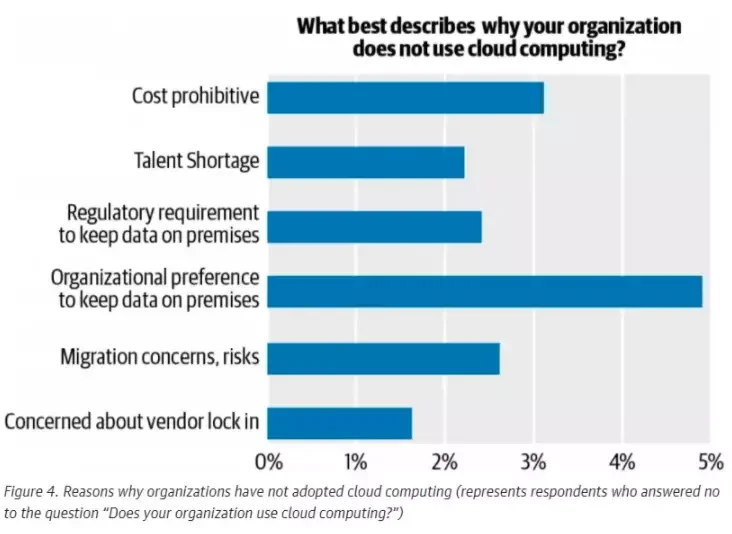
Additionally, McAfee found that 49% of organizations were delaying migration to the cloud because they lacked the security skills the process requires. Considering the cost of resolving a single data breach can be as high as $4.5 million, according to IBM, this makes sense.
But despite the challenges involved, it is essential not to leave migration to chance. One way to ensure migration success is to use the right tools. Here’s how.
What Are Some Top Cloud Migration Tools And Software?
There are several tools you can use to help you move to the cloud hassle-free.
AWS Cloud Migration Services
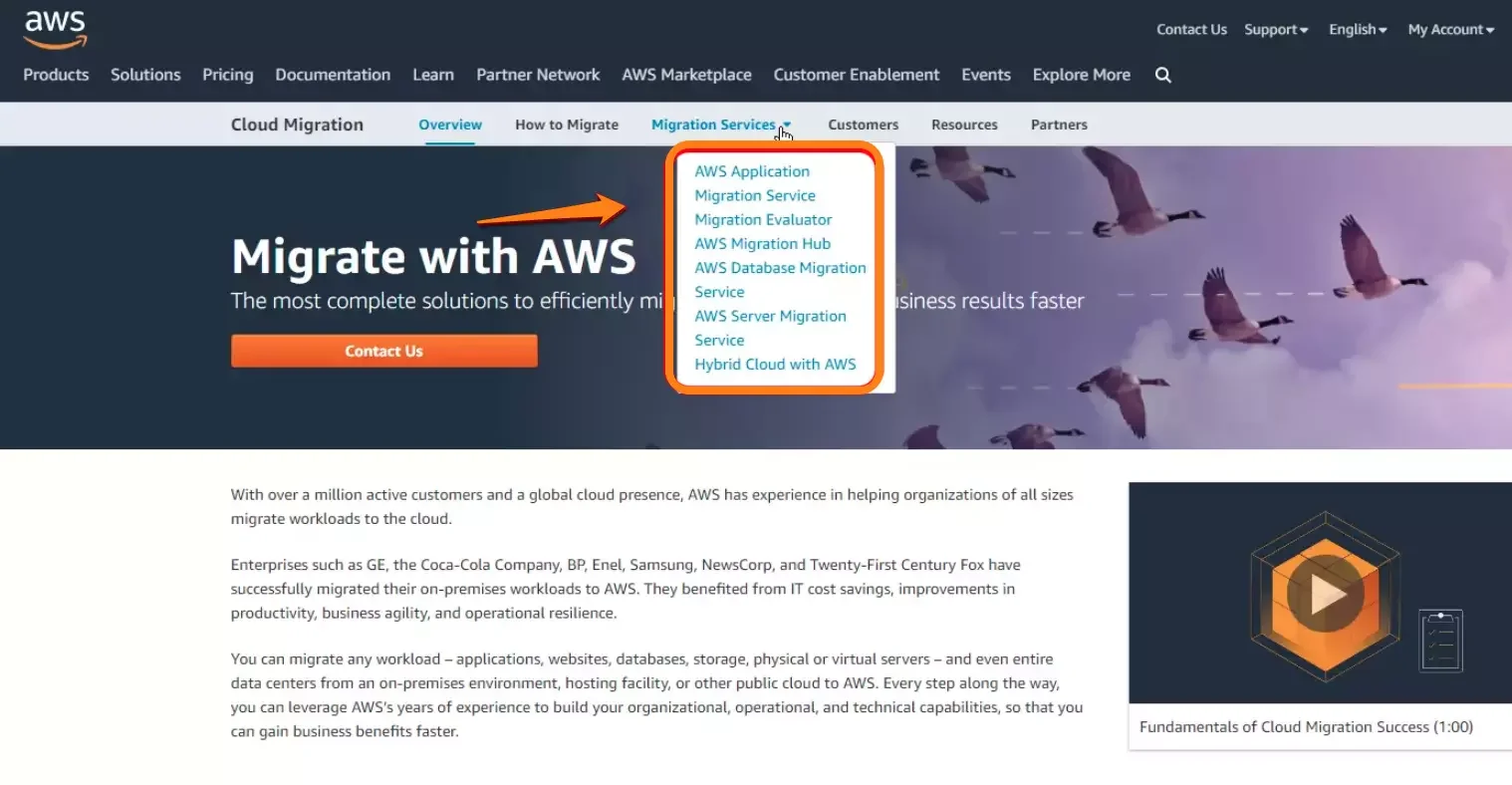
The leading public cloud provider offers several unique, robust, and secure cloud migration tools. These include the AWS data migration service, AWS server migration service, AWS snowmobile, and AWS migration hub.
Alooma

Alooma is a cloud-based data migration solution for enterprises. It makes bringing data from different data silos into BigQuery hassle-free, allowing teams better visibility and control in real-time.
11 Cloud Migration Tips To Ensure Transition Success
The following are some best practices you can follow to ensure a smooth transition.
- Get representatives from all the departments that utilize cloud computing to plan your migration strategy. You want to create a DevSecOps team where everyone contributes unique ideas for maximizing business value in the cloud.
- Next, assign specific roles and responsibilities to these individuals to increase accountability, including cost accountability.
- Set your Key Performance Indicators (KPIs) beforehand to help measure your migration progress against your expectations.
- Identify the project leader who will be accountable for tracking progress against KPIs.
- Evaluate all applications and data to be moved. Any bloat moved to the cloud increases cloud costs unnecessarily.
- Take advantage of an automated tool to gain visibility into your cloud migration process. Automation speeds up processes and reveals potential flaws before they become problems, something a manual process may miss.
- Refactoring your application over time (in manageable phases) can help you utilize cloud-native capabilities, such as microservices and serverless computing.
- Measure migration costs in real-time to prevent overspending. An advanced migration tool such as CloudZero’s MAP Dashboard can assist you here. It also helps your team maximize savings throughout the transition by tracking tagged resources and AWS MAP credits.
- Migrate to the cloud in phases rather than at once to minimize overwhelm. Engineers can also use this approach to test, discover, and fix issues before affecting an entire infrastructure or application.
- Invest in a cloud migration consultant to validate and strengthen your migration strategy. Several platforms provide professional support. For instance, CloudZero’s Cost Intelligence Team will help you develop a foolproof migration strategy and control costs throughout the transition.
- Optimizing your app in the cloud is a continuous improvement process — not a one-time thing. However, it pays back as better application performance and lowers cloud costs.
So, what next?
Migrate To The Cloud With Cost Confidence
There are many benefits to migrating your applications and data to the cloud. Cloud migration offers increased cost savings and scalability benefits in the long run.
But you have to plan ahead, monitor progress continuously, and keep costs under control to ensure a successful transition. The alternative is to overspend, delay deployment, or fail your project entirely.
CloudZero enables engineering teams to confidently move to the cloud by providing powerful cloud cost intelligence.
CloudZero uses machine learning to align cloud costs to specific features, products, teams, customers, and more. It tracks migration costs in real time so teams can see the immediate effects of their architectural decisions. This can help them build cost-effective solutions at every step of the migration.
Lastly, with cost anomaly alerting, engineers can gain insight into trending costs and detect abnormal cost fluctuations before they lead to overspending.
 to see how CloudZero can help you migrate to AWS with cost confidence.
to see how CloudZero can help you migrate to AWS with cost confidence.
